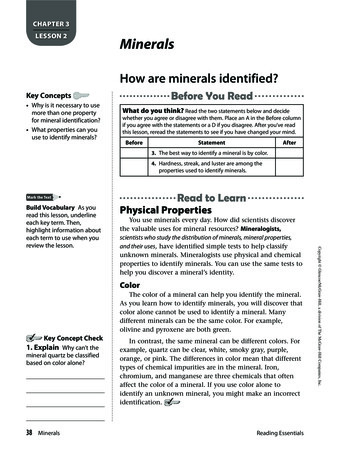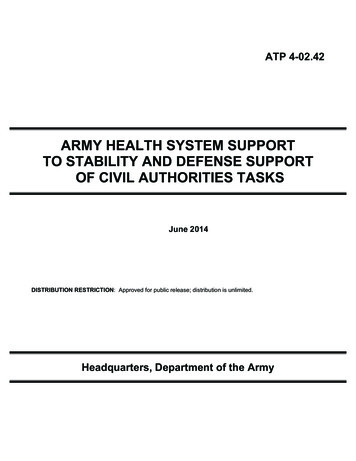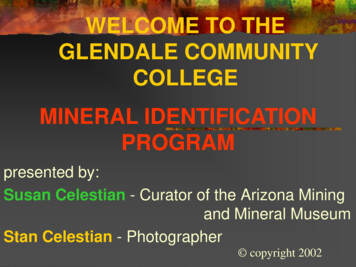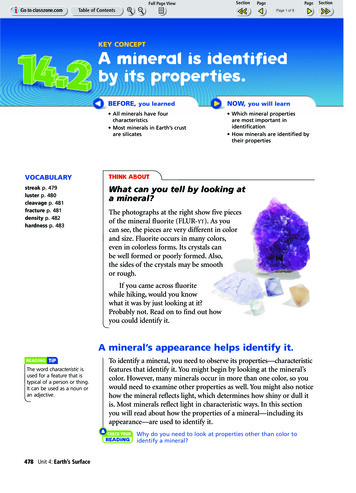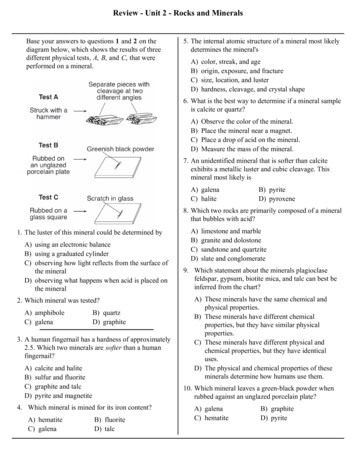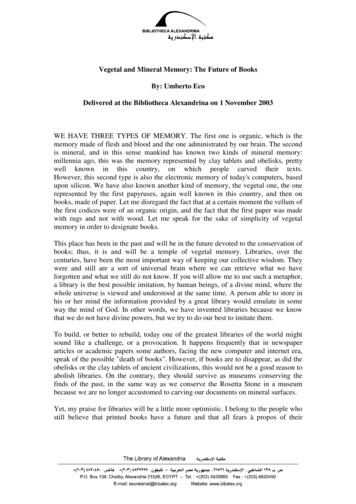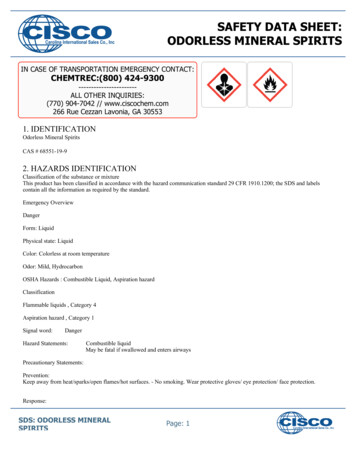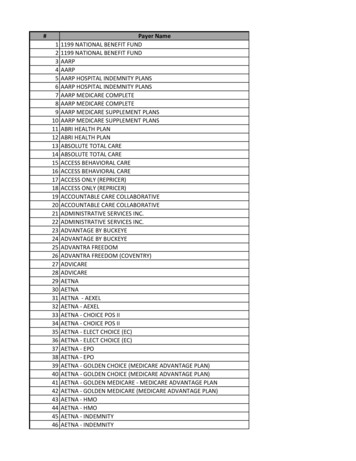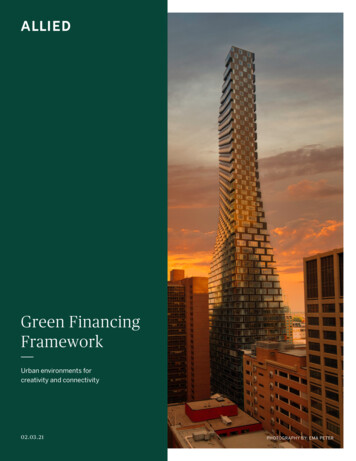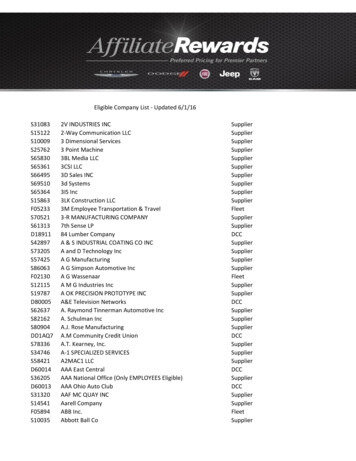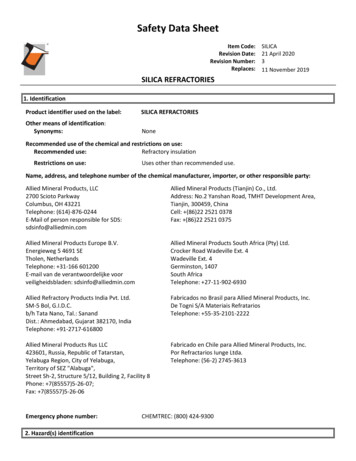
Transcription
Safety Data SheetItem Code:Revision Date:Revision Number:Replaces:SILICA21 April 2020311 November 2019SILICA REFRACTORIES1. IdentificationProduct identifier used on the label:SILICA REFRACTORIESOther means of identification:Synonyms:NoneRecommended use of the chemical and restrictions on use:Recommended use:Refractory insulationRestrictions on use:Uses other than recommended use.Name, address, and telephone number of the chemical manufacturer, importer, or other responsible party:Allied Mineral Products, LLC2700 Scioto ParkwayColumbus, OH 43221Telephone: (614)-876-0244E-Mail of person responsible for SDS:sdsinfo@alliedmin.comAllied Mineral Products (Tianjin) Co., Ltd.Address: No.2 Yanshan Road, TMHT Development Area,Tianjin, 300459, ChinaCell: (86)22 2521 0378Fax: (86)22 2521 0375Allied Mineral Products Europe B.V.Energieweg 5 4691 SETholen, NetherlandsTelephone: 31-166 601200E-mail van de verantwoordelijke voorveiligheidsbladen: sdsinfo@alliedmin.comAllied Mineral Products South Africa (Pty) Ltd.Crocker Road Wadeville Ext. 4Wadeville Ext. 4Germinston, 1407South AfricaTelephone: 27-11-902-6930Allied Refractory Products India Pvt. Ltd.SM-5 Bol, G.I.D.C.b/h Tata Nano, Tal.: SanandDist.: Ahmedabad, Gujarat 382170, IndiaTelephone: 91-2717-616800Fabricados no Brasil para Allied Mineral Products, Inc.De Togni S/A Materiais RefratariosTelephone: 55-35-2101-2222Allied Mineral Products Rus LLC423601, Russia, Republic of Tatarstan,Yelabuga Region, City of Yelabuga,Territory of SEZ "Alabuga",Street Sh-2, Structure 5/12, Building 2, Facility 8Phone: 7(85557)5-26-07;Fax: 7(85557)5-26-06Fabricado en Chile para Allied Mineral Products, Inc.Por Refractarios Iunge Ltda.Telephone: (56-2) 2745-3613Emergency phone number:2. Hazard(s) identificationCHEMTREC: (800) 424-9300
Safety Data SheetItem Code:Revision Date:Revision Number:Replaces:SILICA21 April 2020311 November 2019SILICA REFRACTORIESClassification of the chemical in accordance with paragraph (d) of §1910.1200:GHS HazardSymbols:GHS Classification:Carcinogenicity Category 1ASpecific Target Organ Systemic Toxicity (STOT) - Single Exposure Category1Specific Target Organ Systemic Toxicity (STOT) - Repeated ExposureCategory 1Signal Word:DangerHazard Statements:H350 - May cause cancerH370 - Causes damage to organsH372 - Causes damage to organs through prolonged or repeatedexposurePrecautionary Statements:Prevention:P201 - Obtain special instructions before use.P202 - Do not handle until all safety precautions have been read andunderstood.P260 - Do not breathe dust/fume/gas/mist/vapours/spray.P264 - Wash thoroughly after handling.P270 - Do not eat, drink or smoke when using this product.P280 - Wear protective gloves/protective clothing/eye protection/faceprotection.Response:P307 P311 - IF exposed: Call a POISON CENTER or doctor/physician.P308 P313 - IF exposed or concerned: Get medical advice/ attention.P314 - Get medical advice/attention if you feel unwell.P321 - Specific treatment (see Sections 4 to 8 on this SDS and anyadditional information on this label).Disposal:P501 - Dispose of contents/container to a suitable disposal site inPage 2 of 15
Safety Data SheetItem Code:Revision Date:Revision Number:Replaces:SILICA21 April 2020311 November 2019SILICA REFRACTORIESaccordance with local/national/international regulations.Hazards not otherwise classified:This product also contains nuisance dust. Although the nuisance dustcontains no additional hazards, appropriate PPE should be used.Cancer Statement:Crystalline silica exists in several forms, the most common of which isquartz. If crystalline silica (quartz) is heated to more than 870 C (1600 F)it can change to a form of crystalline silica known as trydimite, and ifcrystalline silica (quartz) is heated to more than 1470 C (2680 F), it canchange to a form of crystalline silica known as cristobalite. Crystallinesilica as trydimite and cristobalite are more fibrogenic than crystallinesilica as quartz. IARC has listed crystalline silica from occupationalsources as a Group I carcinogen. A Group I carcinogen is one in whichthere is sufficient evidence for carcinogenicity in humans. NTP has listedcrystalline silica as reasonably anticipated to be a carcinogen.3. Composition/information on ingredientsChemical NameSilica, Crystalline quartz (nonrespirable)Silica, Crystalline quartz(respirable)Non Hazardous components *Common name andsynonymsNoneCAS #%14808-60-780 - 99None14808-60-75 - 10Not applicableNot applicableBalance* The non hazardous ingredients percentage includes the components that are hazardous but below the thresholdfor GHS classification. In the case where there are no hazardous components, the percentage of non hazardousingredients will be 100%.One or more hazardous ingredient(s) is claimed as a trade secret under the OSHA Hazard Communication Standard.The hazards of this (these) ingredient(s) are given on this SDS.4. First-aid measuresDescription of necessary measures, subdivided according to the different routes of exposure, i.e., inhalation, skinand eye contact, and ingestion:Inhalation:Remove to fresh air. If not breathing, give artificial respiration or giveoxygen by trained personnel. Seek immediate medical attention.Page 3 of 15
Safety Data SheetItem Code:Revision Date:Revision Number:Replaces:SILICA21 April 2020311 November 2019SILICA REFRACTORIESEye Contact:Immediately flush eyes with plenty of water for at least 15 minutes. Seekmedical attention if irritation persists.Skin Contact:Wash with soap and water. Seek medical attention if irritation developsor persists.Ingestion:No hazard expected under normal industrial use. If swallowed, seekmedical attention.Most important symptoms/effects,acute and delayed:Causes damage to organs. Causes damage to organs through prolongedor repeated exposure.Indication of immediate medicalattention and special treatmentneeded, if necessary:Get medical advice/attention if you feel unwell. If exposed or concerned:Get medical advice/ attention. If exposed: Call a poison center/doctor.Specific treatment (see Sections 4 to 8 on this SDS and any additionalinformation on this label).5. Fire-fighting measuresSuitable (and unsuitable) extinguishing media:Suitable extinguishing media:Use methods suitable to fight surrounding fire.Unsuitable extinguishing media:None KnownSpecific hazards arising from thechemical:Hazardous combustion products:Special protective equipment andprecautions for fire-fighters:This product is noncombustible and will not ignite or contribute to theintensity of a fire.Not applicableAs in any fire, wear self-contained breathing apparatus pressure-demand,(MSHA/NIOSH approved or equivalent) and full protective gear.6. Accidental release measuresPersonal precautions, protectiveequipment and emergency procedures:Personal Protective Equipment should be worn as indicated in Section 8.Methods and materials for containmentand cleaning up:Vacuum or sweep up material and place in a disposal container. Avoiddust generation. Exhaust ventilation is recommended to maintainairborne dust concentrations below regulatory exposure levels. Consultindividual operating permits for allowable air emissions. Dusts of asPage 4 of 15
Safety Data SheetItem Code:Revision Date:Revision Number:Replaces:SILICA21 April 2020311 November 2019SILICA REFRACTORIESmanufactured refractory product have a low order of aquatic toxicity, areinsoluble, and are not very mobile. Based upon this information, it is notbelieved to be a significant threat to the environment if accidentallyreleased into water. Dusts of as-manufactured refractory product arenot believed to be a significant threat to the environment if accidentallyreleased on land. Dust and material generated during maintenance andtear-out operations may be contaminated with other hazardoussubstances (e.g., metals & alkaline materials). Evaluation of dust andmaterial from specific processes should be performed to determine if anenvironmental threat exists in the case of a release. Clean up usingmethods which avoid dust generation. Compressed air should not beused to clean up spills. Wear appropriate personal protective equipment.Collect material in a compatible and appropriately labeled container.Dispose of material from processing, installation, maintenance, or tearout operations in accordance with applicable regulations.7. Handling and storagePrecautions for safe handling:Steam spalling, which can lead to personal injury, may result fromimproper drying and firing procedures. For safest use and optimumperformance, proper practices must be followed.Conditions for safe storage, includingany incompatibilities:Safe storage conditions:Materials to Avoid/ChemicalIncompatibility:Store in a dry area.Strong acids, bases, oxidizing agents.8. Exposure controls/personal protectionOSHA permissible exposure limit (PEL), American Conference of Governmental Industrial Hygienists (ACGIH)Threshold Limit Value (TLV), and any other exposure limit used or recommended by the chemical manufacturer,importer, or employer preparing the safety data sheet, where available:Chemical componentSilica, Crystalline quartz(non- respirable)OSHA PEL0.05 mg/m3Silica, Crystalline quartz0.05 mg/m3ACGIH TLV0.025 mg/m3 TWA(respirableparticulate matter)0.025 mg/m3 TWAPage 5 of 15ACGIH STELNot establishedIDLH50 mg/m3 IDLH(respirable dust)Not established50 mg/m3 IDLH
Safety Data SheetItem Code:Revision Date:Revision Number:Replaces:SILICA21 April 2020311 November 2019SILICA REFRACTORIES(respirable)Appropriate engineering controls:(respirableparticulate matter)(respirable dust)Local exhaust ventilation may be necessary to control any aircontaminants to within their exposure limits during the use of thisproduct.Individual protection measures, such as personal protective equipment:Respiratory Protection:Recommend chest X-rays and yearly vital capacity tests for employeesregularly exposed to silica for early detection of silicosis. Comply with allguidelines for crystalline silica exposure.Respirator Type(s):If it is not possible to reduce airborne exposure levels to below the exposure limits with ventilation, use the tablebelow to assist you in selecting respirators that will reduce personal exposures to below the exposure limits.The assigned protection factor (APF) is the minimum anticipated level of protection provided by each type ofrespirator worn in accordance with an adequate respiratory protection program. For example, an APF of 10 meansthat the respirator should reduce the airborne concentration of a particulate by a factor of 10, so that if theworkplace concentration of a particulate was 150 ug/m3, then a respirator with an APF of 10 should reduce theconcentration of particulate to 15 ug/m3.AssignedProtectionFactor102550Type of RespiratorAny air-purifying elastomeric half-mask respirator equipped with appropriate type ofparticulate filter.Appropriate filtering facepiece respirator.Any air-purifying full facepiece respirator equipped with appropriate type ofparticulate filter.Any negative pressure (demand) supplied-air respirator equipped with a half-mask.Any powered air-purifying respirator equipped with a hood or helmet and a highefficiency (HEPA) filter.Any continuous flow supplied-air respirator equipped with a hood or helmet.Any air-purifying full facepiece respirator equipped with N-100, R-100, or P-100filter(s).Any powered air-purifying respirator equipped with a tight-fitting facepiece (half orfull facepiece) and a high-efficiency filter.Any negative pressure (demand) supplied-air respirator equipped with a fullfacepiece.Any continuous flow supplied-air respirator equipped with a tight-fitting facepiecePage 6 of 15
Safety Data SheetItem Code:Revision Date:Revision Number:Replaces:SILICA21 April 2020311 November 2019SILICA REFRACTORIES1000(half or full facepiece).Any negative pressure (demand) self-contained respirator equipped with a fullfacepiece.Any pressure-demand supplied-air respirator equipped with a half-mask.Eye protection:Wear safety glasses with side shields (or goggles) and a face shield.Skin protection:Wear clothing which minimizes skin contact or exposure.Gloves:The correct choice of protective gloves depends upon the chemicalsbeing handled, the conditions of work and type of use. Gloves should bechosen in consultation with the supplier/manufacturer and with a fullassessment of the working conditions.Other protective equipment:Wear clothing which minimizes skin contact or exposure.General hygiene conditions:Wear protective gloves/protective clothing/eye protection/faceprotection. Do not eat, drink or smoke when using this product. Washthoroughly after handling.9. Physical and chemical propertiesAppearance (physical state, color etc.):Physical state:Color:Odor:Odor Threshold:pH:Melting point/freezing point ( C):Granular solidOff-white to dark grayNo OdorNo data availableNot applicableMelting Point ( C): 2000 F ( 1100 C)Freezing point ( C):Not applicableInitial boiling point and boiling range( C):Flash Point ( C):Not applicableEvaporation Rate:Flammability (solid, gas):Upper/lower flammability or explosiveNo data availableNon-flammableNot applicablePage 7 of 15
Safety Data SheetItem Code:Revision Date:Revision Number:Replaces:SILICA21 April 2020311 November 2019SILICA REFRACTORIESlimits:Upper flammability or explosivelimits:Lower flammability or explosivelimits:Vapor pressure:Vapor density:Relative density:Solubility(ies):Partition coefficient: n-octanol/water:Auto-ignition temperature ( C):Decomposition temperature ( C):Viscosity:Not applicableNot applicableNot applicableNot applicable2 to 3.5 g/cc 3%Not applicableNot applicableNot applicableNot applicableVolatile Organic Chemicals:Not establishedBulk Density:No data available10. Stability and reactivityReactivity:Not expected to be reactiveChemical stability:Stable under normal conditions.Possibility of hazardous reactions:None expected under standard conditions of storageConditions to avoid (e.g., staticdischarge, shock, or vibration):Not applicableIncompatible materials:Strong acids, bases, oxidizing agents.Hazardous decomposition products:Not applicable11. Toxicological informationDescription of the various toxicological (health) effects and the available data used to identify those effects:Information on the likely routes ofexposure (inhalation, ingestion, skinand eye contact):Inhalation, skin contact.Symptoms related to the physical,chemical and toxicologicalCauses damage to organs. Causes damage to organs through prolongedPage 8 of 15
Safety Data SheetItem Code:Revision Date:Revision Number:Replaces:SILICA21 April 2020311 November 2019SILICA REFRACTORIEScharacteristics:or repeated exposure.Additional Information:SILICOSIS- The major concern is silicosis, caused by the inhalation andretention of respirable crystalline silica dust. Silicosis can exist in severalforms, chronic (or ordinary), and accelerated (or acute). Chronic orOrdinary Silicosis is the most common form of silicosis, and can occurafter many years of exposure to relatively low levels of airbornerespirable crystalline silica dust. It is further defined as either simple orcomplicated silicosis. Simple Silicosis is characterized by lung lesions(shown as radiographic opacities) less than 1 centimeter in diameter,primarily in the upper lung zones. Often, simple silicosis is not associatedwith symptoms, detectable changes in lung function, or disability. Simplesilicosis may be progressive and may develop into complicated silicosis orprogressive massive fibrosis (PMF). Complicated Silicosis or PMF ischaracterized by lung lesions (shown as radiographic opacities) greaterthan 1 centimeter in diameter. Although there may be no symptomsassociated with complicated silicosis or PMF, the symptoms, if present,are shortness of breath, wheezing, cough, and sputum production.Complicated silicosis or PMF may lead to death. Advanced complicatedsilicosis or PMF can result in heart disease secondary to the lung disease(corpulmonale). Accelerated Silicosis can occur with exposure to highconcentrations of respirable crystalline silica over a relatively shortperiod; the lung lesions can appear within five (5) years of the initialexposure. The progression can be rapid. Accelerated Silicosis is similar tochronic or ordinary silicosis, except that the lung lesions appear earlierand the progression is more rapid. Acute Silicosis can occur withexposures to very high concentrations of respirable crystalline silica overa very short time period, sometimes as short as a few months. Thesymptoms of acute silicosis include progressive shortness of breath,fever, cough, and weight loss. Acute silicosis is fatal.SCLERODERMA- There is evidence that exposure to respirable crystallinesilica or that the disease silicosis is associated with the increasedincidence of scleroderma, an immune system disorder manifested by afibrosis (scarring) of the lungs, skin, and other internal organs. Recently,the American Thoracic Society noted that "there is persuasive evidencerelating scleroderma to occupational silica exposures in settings wherethere is appreciable silicosis risk". The following may be consulted foradditional information on silica, silicosis, and scleroderma (also known asPage 9 of 15
Safety Data SheetItem Code:Revision Date:Revision Number:Replaces:SILICA21 April 2020311 November 2019SILICA REFRACTORIESprogressive systemic sclerosis): Occupational Lung Disorders, ThirdEdition, Chapter 12, entitled "Silicosis and Related Diseases", Parkes, W.Raymond (1994). "Adverse Effects of Crystalline Silica Exposure",American Journal of Respiratory and Critical Care Medicine, Volume 155,pp. 761-765 (1997).TUBERCULOSIS- Individuals with silicosis are at increased risk to developtuberculosis, if exposed to persons with tuberculosis. The following maybe consulted for further information: Occupational Lung Disorders, ThirdEdition, Chapter 12, entitled "Silicosis and Related Diseases", Parkes, W.Raymond (1994). "Adverse Effects of Crystalline Silica Exposure",American Journal of Respiratory and Critical Care Medicine, Volume 155,pp. 761-765 (1997).NEPHROTOXICITY- There are several recent studies suggesting thatexposure to respirable crystalline silica or that the disease silicosis isassociated with the increased incidence of kidney disorders. Thefollowing may be consulted for additional information on silica, silicosis,and nephrotoxicity: Occupational Lung Disorders, Third Edition, Chapter12, entitled "Silicosis and Related Diseases", Parkes, W. Ramond (1994)."Further evidence of human silica nephrotoxicity in occupationallyexposed workers", British Journal of Industrial Medicine, Vol 50, No. 10,pp. 907-912 (1993). "Adverse Effects of Crystalline Silica Exposure",American Journal of Respiratory and Critical Care Medicine, Volume 155,pp. 761-765 (1997).ARTHRITIS- There are recent studies suggesting that exposure torespirable crystalline silica or that the disease silicosis is associated withthe increased incidence of arthritis. The following may be consulted foradditional information on silica exposure and arthritis: American Journalof Industrial Medicine, Volume 35, pp. 375-381 "Connective TissueDisease and Silicosis", Rosenman KD; Moore-Fuller M.; Reilly MJ. (1999).Environmental Health Perspective, Volume 107, pp. 793802"Occupational Exposure to Crystalline Silica and Autoimmune Disease",Parks CG, Conrad K, Cooper GS. (1999).Page 10 of 15
Safety Data SheetItem Code:Revision Date:Revision Number:Replaces:SILICA21 April 2020311 November 2019SILICA REFRACTORIESDelayed and immediate effects and also chronic effects from short- and long-term exposure:Ingestion Toxicity:Not a likely route of entry.Skin Contact:Cement dust and/or wet, unhardened product can dry the skin and causealkali burns.Inhalation Toxicity:May include shortness of breath, wheezing, coughing, and sputumproduction.Eye Contact:Cement dust and/or wet, unhardened product can cause burns to theeyes.Sensitization:None KnownReproductive and DevelopmentalToxicity:No data availableCarcinogenicity:Classification has been based on toxicological information of thecomponents in Section 3.STOT-single exposure:Classification has been based on toxicological information of thecomponents in Section 3.STOT-repeated exposure:Classification has been based on toxicological information of thecomponents in Section 3.Aspiration hazard:Based on available data, the classification criteria are not met.Numerical measures of toxicity (such as acute toxicity estimates):Chemical NameLD50 OralLD50 DermalLC50 InhalationNo data availableIs the hazardous chemical is listed in the National Toxicology Program (NTP) Report on Carcinogens (latest edition) orhas been found to be a potential carcinogen in the International Agency for Research on Cancer (IARC) Monographs(latest edition), or by OSHA:Chemical NameSilica, Crystalline quartz(non- respirable)Silica, Crystalline quartz(respirable)OSHA CarcinogenIARC CarcinogenNTP CarcinogenNYesYesNYesYes12. Ecological informationPage 11 of 15
Safety Data SheetItem Code:Revision Date:Revision Number:Replaces:SILICA21 April 2020311 November 2019SILICA REFRACTORIESEcotoxicity (aquatic and terrestrial,where available):Dusts of as-manufactured refractory product have a low order of aquatictoxicity, are insoluble, and are not very mobile. Based upon thisinformation, it is not believed to be a significant threat to theenvironment if accidentally released on land or into water. However,dust and material generated during maintenance and tear-out operationsmay be contaminated with other hazardous substances (e.g., metals,respirable crystalline silica, alkaline materials). Evaluation of dust andmaterial from specific processes should be performed to determine if anenvironmental threat exists in the case of release.Ecological Toxicity Data:Chemical NameCAS #Aquatic EC50CrustaceaAquatic ERC50AlgaeAquatic LC50 FishNo data availablePersistence and degradability:Not applicableBioaccumulative potential:Not applicableMobility in soil:Not applicableOther adverse effects (such ashazardous to the ozone layer):None Known13. Disposal considerationsDescription of waste residues andinformation on their safe handling andmethods of disposal, including thedisposal of any contaminatedpackaging:The as-manufactured refractory product or refractory dust is notconsidered a hazardous waste. Dust and material generated during use,maintenance and tear-out operations may be contaminated with otherhazardous substances (e.g., metals, alkaline materials) from a particularapplication. Additionally, the spent refractory could contain reactionproducts not originally present in the supplied refractory material.Contaminants or reaction products have the potential to cause therefractory waste to exhibit hazardous waste characteristics. It is theresponsibility of the user to consult applicable regulations prior todisposal of any industrial product to ensure waste disposal compliance.Waste analysis and characterization may be necessary to determinePage 12 of 15
Safety Data SheetItem Code:Revision Date:Revision Number:Replaces:SILICA21 April 2020311 November 2019SILICA REFRACTORIESproper waste disposal. Waste Management: Dusts could containrespiratory hazards. To prevent waste materials becoming airborneduring waste generation, storage, transportation, and disposal, properdust control measures are recommended.14. Transport informationCarriage of dangerous goods by road (DOT), rail or inland waterways:UN number:Not Regulated for TransportUN Proper shipping name:Not applicableTransport hazard class(es):Not applicablePacking group, if applicable:Not applicableInternational carriage of dangerous goods by sea (IMDG/IMO):UN number:Not Regulated for TransportUN Proper shipping name:Not applicableTransport hazard class(es):Not applicablePacking group, if applicable:Not applicableInternational carriage of dangerous goods by air (IATA):UN number:Not Regulated for TransportUN Proper shipping name:Not applicableTransport hazard class(es):Not applicablePacking group, if applicable:Not applicableEnvironmental hazards (e.g., Marinepollutant (Yes/No)):NoTransport in bulk (according to Annex IIof MARPOL 73/78 and the IBC Code):No data availableSpecial precautions which a user needsto be aware of or needs to comply within connection with transport orconveyance either within or outsidetheir premises:No data available15. Regulatory informationPage 13 of 15
Safety Data SheetItem Code:Revision Date:Revision Number:Replaces:SILICA21 April 2020311 November 2019SILICA REFRACTORIESSafety, health and environmental regulations specific for the product in question:TSCA Status:All components in this product are on the TSCA Inventory.Regulated Components:Chemical NameSilica, Crystallinequartz (nonrespirable)Silica, Crystallinequartz (respirable)Chemical NameSilica, Crystallinequartz (nonrespirable)Silica, Crystallinequartz (respirable)Chemical NameSilica, Crystallinequartz (nonrespirable)Silica, Crystallinequartz (respirable)CAS #CERCLASara EHSSara 313U.S. HAP14808-60-7NNNN14808-60-7NNNNCAS #California Prop65 - CancerCalifornia Prop65 - Dev. ToxicityCalifornia Prop65 - Reprod femCalifornia Prop65 - Reprod dousSubstanceListCAS #MassachusettsRTK ListNew JerseyRTK ListPennsylvaniaRTK ListRhodeIsland 6. Other information, including date of preparation or last revision.SDS Prepared by:Environmental, Health & Safety ComplianceRevision Date:21 April 2020Revision Number:3Page 14 of 15
Safety Data SheetItem Code:Revision Date:Revision Number:Replaces:SILICA21 April 2020311 November 2019SILICA REFRACTORIESReason for revision:Abbreviations and acronyms:New GHS Format.CAS Chemical Abstract ServiceDNEL Derivative No Effect LevelEC European CommunityEINECS European Inventory of Existing Chemical SubstancesMSHA Mine Safety Health AdministrationNIOSH National Institute of Occupational Safety & HealthOEL Occupational Exposure LimitPBT Persistent, Bioaccumulative, ToxicPNEC Predicted No Effect ConcentrationSCOEL Scientific Committee on Occupational Exposure LimitsTLV Threshold Limit ValueTWA Time Weighted AveragevPvB Very Persistent, Very BioaccumulativeWt.% Weight PercentDisclaimer:All information provided here is based on data believed to be reliable.However, THE INFORMATION AND THE PRODUCT ARE PROVIDEDWITHOUT ANY REPRESENTATION OR WARRANTY, EXPRESS OR IMPLIED,INCLUDING BUT NOT LIMITED TO REPRESENTATIONS AND WARRANTIESREGARDING ACCURACY OR CORRECTNESS, THE EFFECTS OF USING THEPRODUCT, THE RESULTS TO BE OBTAINED, FITNESS FOR A PARTICULARPURPOSE, OR THE SAFETY OR TOXICITY OF THE PRODUCT. It is the users'responsibility to determine the safety, toxicity, and suitability for theiruse of the product and to comply with all applicable statutes andregulations. The conditions or methods of handling, storage, use, anddisposal of the product are beyond our control. For this and otherreasons, Allied Mineral Products, LLC. does not assume responsibility andexpressly disclaims liability for loss, damage, or expense arising out of,relating to, or in any way connected with the handling, storage, use, ordisposal of this product. This SDS is not intended as a license to operateunder, or a recommendation to infringe on, any patents. Appropriatewarnings and safe handling instructions should be provided to handlersand users.Page 15 of 15
Allied Mineral Products, LLC 2700 Scioto Parkway Columbus, OH 43221 Telephone: (614)-876-0244 E-Mail of person responsible for SDS: sdsinfo@alliedmin.com Allied Mineral Products (Tianjin) Co., Ltd. Address: No.2 Yanshan Road, TMHT Development Area, Tianjin, 300459, China Cell: (86)22 2521 0378 Fax: (86)22 2521 0375
